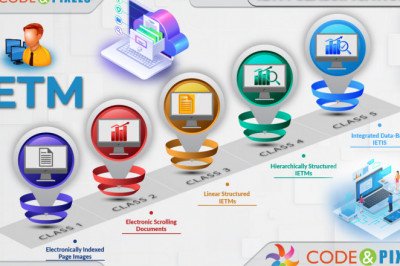views
What is the Metaverse?
Overview of the Metaverse
Metaverse is a 3D virtual space created on the Internet .
The word Metaverse , which means “another universe or another world,” was created by combining two words, meta , which means “to exceed,” and universe, which means “ universe.”
It may be difficult to get an image from just the meaning of the word, but for example, Nintendo’s popular game “Animal Crossing: New Horizons”, in which “you” live in a village where unique animals live, or the world’s number one game . Games such as “Minecraft” , a monster game played by over 40 million people , are also a kind of Metaverse development in the sense of a 3D virtual space.
Metaverse already existed as a concept through consumer games, but recent improvements in VR/AR technology have led to the creation of “virtual spaces that are closer to reality (higher reality).”
By improving the quality of the virtual space and linking with various new technologies that will be introduced later, the Metaverse will go beyond the category of a simple game and play an important role in Web 3.0 (the next generation decentralized internet). Become.
Why the Metaverse is getting attention
In recent years, the word “metaverse” has been used more often not only on social media but also on TV news. Among them, on October 28, 2021, Facebook, which is familiar to many people, changed its company name to “Meta” , which became a big topic and became one of the triggers to attract attention to “Metaverse”.
What is Web3.0?
- Web 1.0 (Homepage era)
The Web 1.0 era was a time when search engines such as Yahoo!, Google, and MSN Search began to appear, and the web was still a one-way street. Web designer Darci DiNucci used the terms Web 1.0 and Web 2.0 in 1999 to distinguish between stages of evolution.
Websites were created using static HTML pages in the early 1990s, and the culture of individuals having their own “homepages” to disseminate information was born from this era. However, the Internet connection speed was also very slow and it took a long time to display even one image.
In addition, since the information that can be viewed is managed only by the information creator, the viewing user cannot edit the data. Because of these characteristics, web 1.0 is also called the “unidirectional era.”
Web2.0 (SNS era)
In the Web 2.0 era, SNS such as YouTube, Twitter, and Instagram appeared, and everyone became a sender. While the Web 1.0 era was called the “one-way era,” the Web 2.0 era has made it possible to exchange information in both directions with various people .
It was also an era when platform services called GAFA, such as Google, Amazon, Facebook (formerly Meta), and Apple, made great strides and became giant tech companies.
On the other hand, the possibility of infringement of personal privacy due to the concentration of personal information in specific companies such as GAFA is being viewed as a problem. This is because the information collected by some large companies includes not only basic personal information such as address, age, and gender, but also personal preferences and behavior history, which are available for use.
It has also been pointed out that centralized information management is susceptible to cyberattacks and may affect many users. In fact, in 2018, the major SNS “Facebook”, which is a corner of GAFA, leaked the user information of more than 50 million people to the outside.
Web 3.0 (Distributed Internet era)
As mentioned at the beginning, Web 3.0 refers to the “next generation distributed Internet” . In addition, from the current situation where personal information is concentrated in GAFA and other giant tech companies, by using next-generation technology to manage information in a distributed manner, it is possible to create a new form of information management that does not concentrate information on giant companies . What is expected is the concept of Web 3.0.
Relationship between Web3.0 and Metaverse
The Metaverse is a “receptacle” for Web 3.0
The Metaverse is, so to speak, a “receptacle” for the various technological innovations that make up Web 3.0 , the “next-generation distributed Internet .”
Web 3.0 is built on the underlying technology of blockchain , and virtual currency literally plays the role of “money” in Web 3.0
And real-world “financial services” will be replaced by DeFi (decentralized finance) in Web3.0 , and NFTs (non-fungible tokens) will clarify the “ownership” of digital assets in Web3.0 . Also, in Web 3.0 , it is expected that the conventional “company organization” will take the form of DAO (Distributed Autonomous Organization) .
The “3D virtual space (receptacle)” that encompasses all of these is exactly the Metaverse .
By linking with various technologies called Web 3.0, the Metaverse will not only be a “3D virtual space created on the Internet”, but also “play, work, trade, and do things just like in the real world.” It has great potential to become a “ virtual world that you can create and interact with” .
Current Issues of the Metaverse in Web3.0
Strengthening hardware
In order to spread the use of the Metaverse in Web 3.0, it is essential to strengthen the hardware side. Specifically, we want to reduce the size and weight of the VR equipment and improve the rendering specs .
Spending more time in virtual worlds requires more immersive, natural and expressive VR equipment . There is still room for improvement in terms of weight and size in order to continue wearing the current VR equipment for several hours. In addition, it can be expected that there will be even higher levels of demand for device specifications that enable faster communication and high-definition virtual worlds.
Meta (former Facebook), which changed its name in October 2021, invests a large amount of money in the field in which the company’s future is at stake. You can see it.
Enrichment of attractive contents
For the spread of the Metaverse, not the evolution of hardware, but the software side, that is, the enhancement of content, is essential. And Japan has the potential to make great strides in this area. This is because Japan is one of the world’s leading “content powerhouses . “
There are many creators in Japan who can create interesting content such as manga, anime, and games , and there is also a culture of respect for creators . In addition, our strength is that we own the rights to world-famous and highly rated works such as Dragon Ball, One Piece, Final Fantasy, and Mario.
Japan is the only country in the world that has all the human resources, culture, and rights to create excellent content .
Summary
In this article, we have provided an overview of Web3.0 (the next-generation distributed Internet) and the Metaverse development company (virtual reality) , and explained the relationship between the two.
The importance of the Metaverse in Web 3.0 will increase even more as VR devices become smaller and lighter, their rendering specs improve, and content becomes more complete.












Comments
0 comment